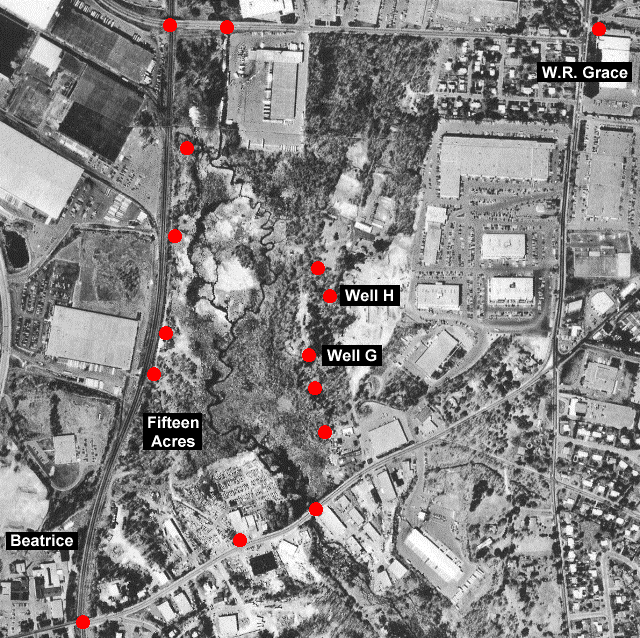Contamination (defined as the changes in average stream water caused by humans) of the
Aberjona River in Massachusetts began as early as 1648, when Woburn's first tannery opened.
The industry continued to expand, and by 1865 Woburn was home to 21 active tanning and
currying shops. VOCs associated with the tanning industry would come to be associated with
severe illness and death in the Woburn community one hundred years later. From 1863 through
1929, Woburn Chemical Works operated one of the country's largest industrial complexes on
what is now dubbed the Industriplex waste site, upriver from the polluted Wells G&H.
Pollution was detected as early as 1927, when the city decided to construct a sewer to
alleviate the problem. In 1958 the city's public water consultant warned that, "the
groundwaters of this [Aberjona River] valley are, in general, too polluted to be used for
a public water supply." Two years later, W.R. Grace & Co. opened a small machine shop in
Woburn. In 1964 the City of Woburn installed Well G in close proximity to the Aberjona
River in order to meet the growing demand for public water, and this installation was to
be followed three years later by the addition of Well H nearby. In 1975, the Massachusetts
Department of Health recommended that Woburn not rely on Wells G & H due to chemical
contamination, and one year later ordered the removal of manganese and iron from these
wells. The wells were finally closed in 1979, when the Massachusetts Department of
Environmental Quality Engineering found them contaminated with several VOCs, including
trichloroethylene and tetrachloroethylene.
During their peak, Wells G & H supplied the City of Woburn with 30% of its public drinking
water. In 1982 eight families charged W. R. Grace & Co. as well as two other local companies
(Beatrice Foods and Unifirst) in a civil action with the deaths of children because of
leukemia that they argued was the result of contamination by these factories. This lawsuit
was the basis for the recent book and movie, "A Civil Action." Evidence was easily
established that the cancer rate in Woburn was higher that would be expected based on national
statistics, and these incidences were eventually linked without significant doubt to the
pollution in the water from Wells G & H.

The question was who was at fault; the companies being charged were young relative to the city's
history, but there was clear evidence of environmental negligence on the part of all three
companies. In the end, the case was settled out of court but Grace conducted significant research
to prove that since 50% of the well water came from the polluted Aberjona River, this was a more
likely source of contamination than the Grace factory which was farther away, on a densely-packed
plateau. The general layout of the area is shown on the map at the left. The Aberjona River is
directly west of Wells G and H, while the Grace factory is farter north and east. Nevertheless,
Grace had been negligible in its disposal of chemicals and waste.